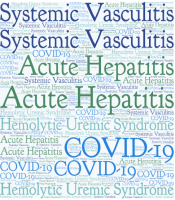Multisystem inflammatory syndrome in children (MISC) is one of the considerable complications in children after Coronavirus disease 2019 (COVID-19) pandemic with multiple organ involvements. In MISC, the immune system exacerbates inflammatory response to previous coronavirus infection, affecting two or more organs. Cardiac complications are one of the most critical organ involvement presented as myocarditis, volvuli involvements, and coronary changes. Moreover, abdominal pain and mesenteric adenitis have been presented as the acute abdominal features (1-4).
The pediatricians faced some new presentations after COVID-19 infection during and after the second wave of Delta variant (2). Meanwhile, the patients fulfilled the Centers for Disease Control and Prevention (CDC) criteria of MISC, including multi-organ failures, elevation of inflammatory parameters, and involvement of special organs with special laboratory data resembling clinical picture of known special disease.
Hemolytic Uremic-Like Syndrome
Hemolytic anemia, hypocomplementemia, and acute kidney injury are the clinical picture resembling Hemolytic Uremic Syndrome (HUS) with the positive history of closed contact in the recent 1 - 2 weeks or positive SARS-COV2 antibodies. Moreover, the inflammatory factors such as ESR, ferritin, D-dimer, fibrinogen, anemia, thrombocytopenia, and lymphopenia are elevated. However, hypocomplementemia, hemolytic anemia, and uremia are specific for these patients.
In both COVID-19 and HUS, the activation of endothelial receptor is the initiator of cytokine storm waterfall associated with severe endothelial dysfunction and thrombo-inflammatory with multiple-organ involvements. Complement activation has a crucial role in HUS-like phenomena. The sustained activation of alternative pathway of complement with virus component leads to severe inflammation beside the coagulation activity (5-7).
Antineutrophil Cytoplasmic Antibodies (ANCA)-Associated-Like Vasculitis
In COVID-19 pandemic, especially in Delta wave, the school-aged (8 - 12 years old) patients were referred with small vessel vasculitis, skin lesions such as palpable purpura, pulmonary involvements (such as lesions, cavity or hemorrhage), gastrointestinal manifestations (such as abdominal angina pain, GI bleeding, and intestinal perforation), and renal involvements (such as pauci-immune glomerulonephritis with ANCA positive test resembling ANCA-associated vasculitis (AAV). Although chronic sinusitis and saddle nose deformity were not detected, some patients had a history of chronic sinusitis.
In genetically susceptible patient, some infections may trigger neutrophil extracellular traps (NETs) with overexpression of PR3 and MPO. Then, antibody production against PR3 and MPO are presented with AAV.
Similarly, in Coronavirus infection, especially in cytokine storm, the NETosis with antibody production against overexpression of antigen or self-antigen, beside the endothelial inflammation directly resemble AAV. In some patients, the clinical presentation had a rapid progressive nature with some immune-thrombosis presentation and vasculitis with poor prognosis. It is not still clear whether coronavirus can trigger the susceptible vasculitis patients or be a new presentation of coronavirus similar to AAV (8-10).
Acute Hepatitis
Acute hepatitis is an unusual critical new presentation in school-aged children. The initial presentation is gastrointestinal complications such as nausea, vomiting, and diarrhea for 1 - 2 weeks before icteric appearance. These patients usually have a history of COVID-19 or familial close contact 4 - 6 weeks before the presentation (11-13).
Recently, about 300 patients reported nearly the same presentations worldwide (14). However, some patients had elevated liver enzyme (15). Severe liver failure with normal liver enzyme lead to liver transplant.
Adenovirus has been detected in about 70% of these patients. The incidence of adenovirus in spring is usual, but pulmonary presentations are more prominent than gastrointestinal manifestations. On the other hand, the co-occurrence of COVID-19 pandemic and adenovirus is not a coincidence. The co-infection of two viruses might play the critical role in this process.
Discussion
Initially, the coronavirus band to ACE2 receptor of cells of respiratory airways, then lead to different respiratory symptoms as other manifestations depend on pulmonary system’s function. Although severe pulmonary involvement is rare in children, those with underlying disorders especially immunodeficiency might experience it.
On the other hand, in school-aged patients the inflammation of other organs such as brain, liver, heart, and kidney represent the activity of immune system one to two months after coronavirus infection in genetically susceble (16) patients. In MISC patients, the cytokine storm from immune system cells such as neutrophils, macrophages, and other innate immune cells lead to organ dysfunction. However, isolated organ involvement such as hepatitis, cardiac or kidney disorder, and CNS support the theory of localized inflammation with stimulation of localized T-cells or especial antibodies from adaptive immune system (17).
The similar process occurs in Kawasaki disease; in the acute phase, the activation of the innate immune system with cytokine release lead to fever and severe inflammation, then in the sub-acute phase and convalescence, the activation of localized T-cells results in localized coronary involvements. The effectiveness of infliximab, which is an anti-TNF medicine, may support this hypothesis (18, 19).
In addition, the residual coronavirus antigen in localized cell may be triggered by other viruses such as adenovirus, and lead to severe stimulation of the immune system with sever organ failure (14, 15).
Overall, the post-COVID-19 inflammation could be severe with localized organ failures. The stimulation of immune system, especially T cells has a main role in this process. So, immunosuppressive medicine could be helpful in cases of post-COVID-19 severe inflammation.


